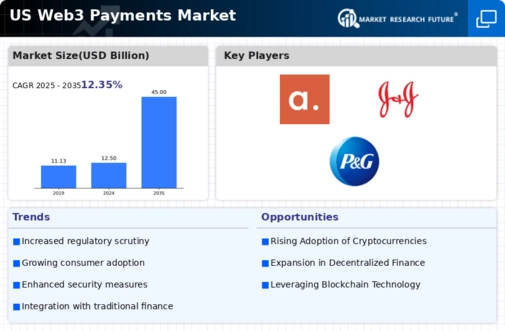Growing Demand for Decentralized Finance
The web3 payments market is experiencing a notable surge in demand for decentralized finance (DeFi) solutions. This trend is driven by consumers seeking alternatives to traditional banking systems, which often involve high fees and slow transaction times. In the US, DeFi platforms have seen a significant increase in user adoption, with reports indicating that the total value locked in DeFi protocols has surpassed $100 billion. This shift towards DeFi is likely to enhance the web3 payments market, as users increasingly prefer peer-to-peer transactions that eliminate intermediaries. Furthermore, the integration of smart contracts within DeFi applications is expected to streamline payment processes, making them more efficient and transparent. As a result, the web3 payments market is poised for substantial growth, fueled by the desire for financial autonomy and innovative payment solutions.
Technological Advancements in Blockchain
Technological advancements in blockchain are playing a crucial role in shaping the web3 payments market. Innovations such as layer-2 scaling solutions and interoperability protocols are enhancing transaction speeds and reducing costs. For instance, the implementation of the Lightning Network has enabled Bitcoin transactions to occur almost instantaneously, which is a significant improvement over traditional transaction times. In the US, blockchain technology is being increasingly adopted by financial institutions, with a reported 40% of banks exploring blockchain for payment processing. These advancements not only improve the user experience but also bolster the security and reliability of transactions. As technology continues to evolve, the web3 payments market is likely to benefit from increased efficiency and a broader range of applications, attracting more users and businesses to adopt these solutions.
Rise of E-commerce and Digital Transactions
The rise of e-commerce and digital transactions is significantly impacting the web3 payments market. As more consumers shift towards online shopping, the demand for seamless and secure payment methods has intensified. In the US, e-commerce sales have reached approximately $900 billion, with a substantial portion of these transactions being conducted using digital currencies. This trend indicates a growing acceptance of cryptocurrencies as a viable payment option among consumers and merchants alike. The web3 payments market is likely to capitalize on this momentum, as businesses seek to integrate cryptocurrency payment solutions to cater to tech-savvy customers. Additionally, the convenience of digital wallets and mobile payment applications is expected to further drive the adoption of web3 payment systems, creating a more integrated and user-friendly shopping experience.
Increased Focus on Privacy and Data Security
In an era where data breaches and privacy concerns are prevalent, the web3 payments market is witnessing an increased focus on privacy and data security. Consumers are becoming more aware of the risks associated with traditional payment methods, which often require sharing sensitive personal information. As a result, there is a growing demand for payment solutions that prioritize user privacy. Web3 technologies, such as zero-knowledge proofs and decentralized identity systems, are emerging as potential solutions to address these concerns. In the US, a survey indicated that over 60% of consumers are willing to use payment systems that offer enhanced privacy features. This shift towards privacy-centric solutions is likely to drive innovation within the web3 payments market, as developers create more secure and user-friendly payment options that align with consumer expectations.
Regulatory Clarity and Compliance Initiatives
Regulatory clarity and compliance initiatives are becoming increasingly important for the web3 payments market. As governments and regulatory bodies in the US establish clearer guidelines for cryptocurrency usage and transactions, businesses are better positioned to navigate the legal landscape. This clarity is essential for fostering trust among consumers and encouraging wider adoption of web3 payment solutions. Recent initiatives by the US government to create a regulatory framework for digital assets suggest a commitment to supporting innovation while ensuring consumer protection. As compliance becomes more streamlined, businesses in the web3 payments market may find it easier to operate and expand their services. This regulatory environment could potentially lead to increased investment and participation in the market, further driving its growth and development.














Leave a Comment